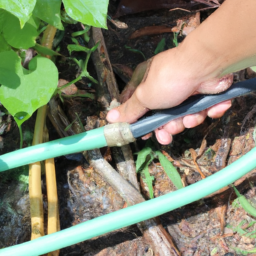Soaker Hose Gardening How To Use In Vegetable Garden
How To Use Soaker Hose In Vegetable Garden
Introduction
Having a vegetable garden is made easier with the use of a soaker hose and the resulting yields can be bountiful. Soaker hoses are particularly useful for rooting systems that need to be constantly moist such as warm-weather vegetables. This article will give an informative guide on how to employ a soaker hose in a vegetable garden to aid in their growth.
What is a Soaker Hose?
A soaker hose is a long length of porous hose with tiny openings that release water when pressure is applied. The constant slow release of water allows for precise watering of your plants, as it typically seeps through the top layer of soil and straight to the root base. This means that you don't need to worry about compromising the garden with over-watering.
Preparing your Garden and Soaker Hose
When it comes to garden set up, there are several steps you'll need to consider before installing your soaker hose. First, you'll need to ensure that the vegetable bed has good drainage and tilt to it. This will help the water move more freely throughout the bed.
When it comes to the soaker hose, you'll want to make sure it is not restricted by anything in the garden as this will lead to the water not dispersing correctly. You'll also want to take the time to ensure the soaker hose is even, with no kinks or twists.
Positioning and Connections
Before laying your soaker hose, you want to decide which vegetables you'll be planting. This will help you to arrange your soaker hose accordingly. Generally, symmetrical designs for the hose are the most successful. Additionally, you should also leave some space between the soaker hose and your vegetable bed, this will allow the roots to have adequate space to grow.
After the layout of the soaker hose is complete, the hose can be connected to the water source. There are different types of fittings available, and it is crucial to use the correct type, even the smallest of details can make a big difference.
Planting
Once the soaker hose is connected to the water source it is now the ideal time to start planting your vegetables. Additionally, it is beneficial to add compost or fertilizer to ensure the vegetables have the necessary nutrients
Watering
Once your vegetables have been planted, water adequately by turning the tap nearest to the garden fully on and letting the soaker hose do the rest. At this stage it is important not to let your vegetables dry out; however, don't overwater either as this can lead to rot.
Cleaning
At the end of each season, it is important to clean and flush out the soaker hose, this will ensure the hose is free from sediment or sludge which over time can restrict the flow of water and also clog nozzles of the hose.
In Summary
This guide to using a soaker hose in a vegetable garden has outlined the steps needed from preparation to planting. Utilizing a soaker hose can assist with helping to maintain consistent water levels for root growth, ensuring greater yields of vegetables. It is paramount to take the time setting up the garden, laying the soaker hose, and connecting the correct fittings to guarantee perfect garden growing conditions.
References:
1. https://www.articles.howtogeek.com/how-to/installing-soaker-hose-in-your-garden/
2. https://www.motherearthnews.com/organic-gardening/soaker-hose-basics-zbcz1302
3. https://www.realsimple.com/home-organizing/gardening/tool-tips/installing-soaker-hose

Previous Page
